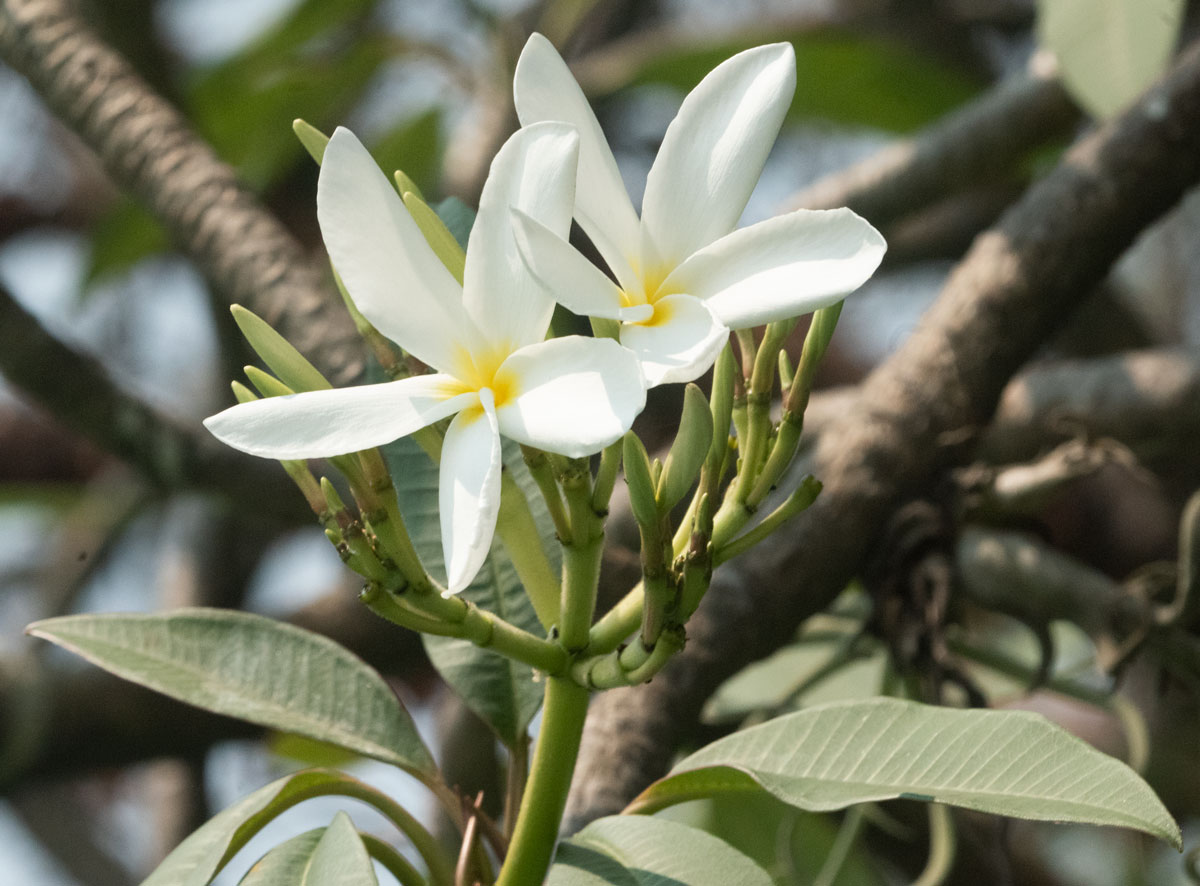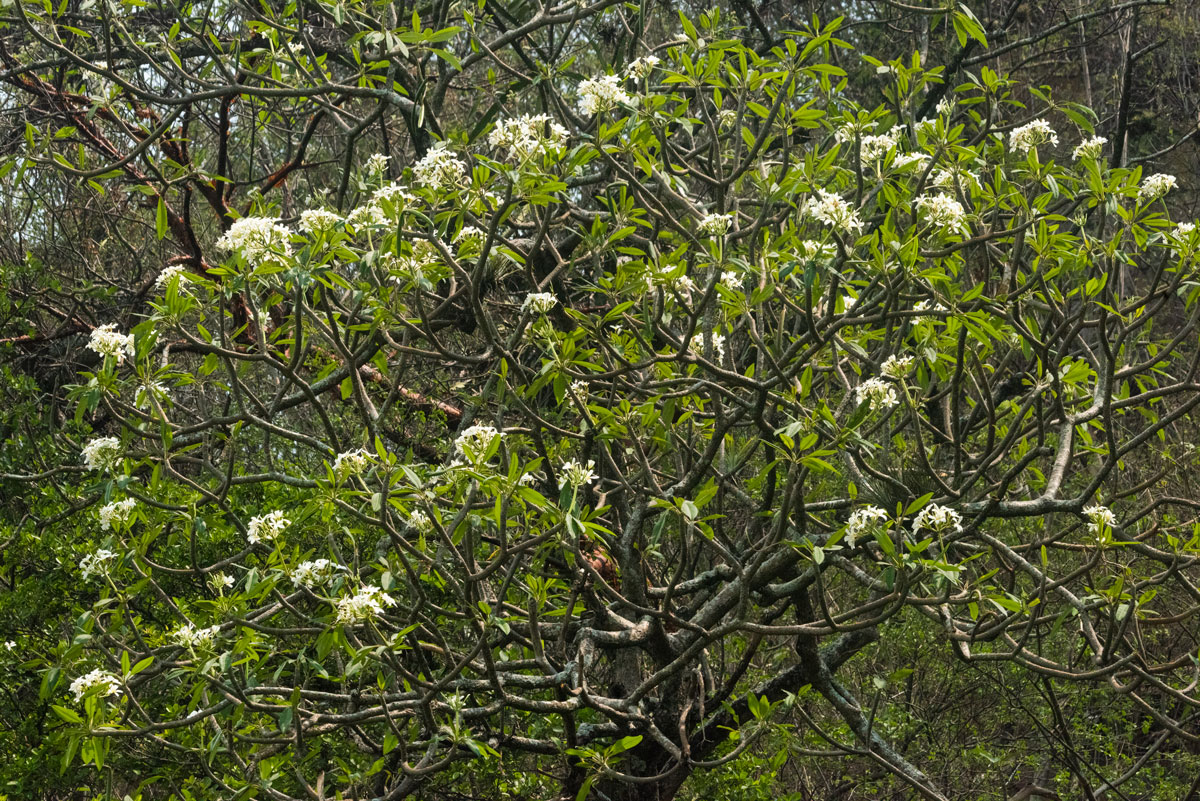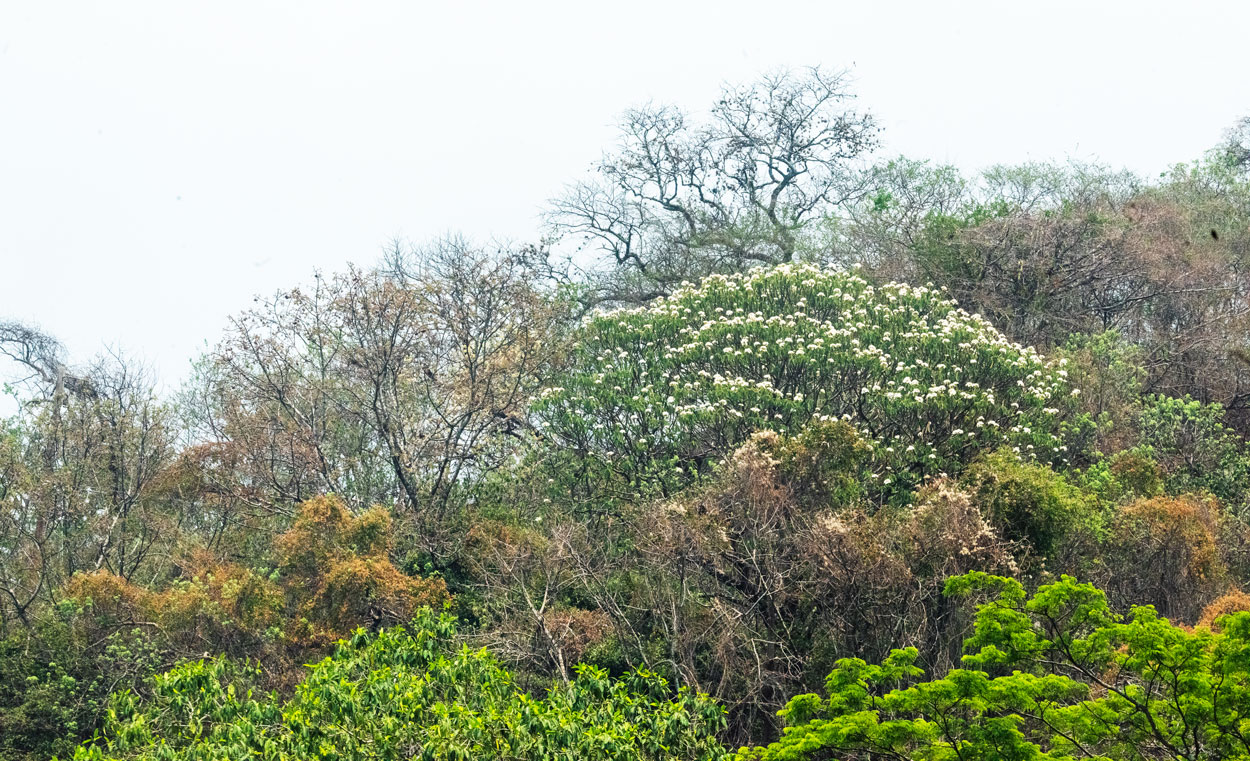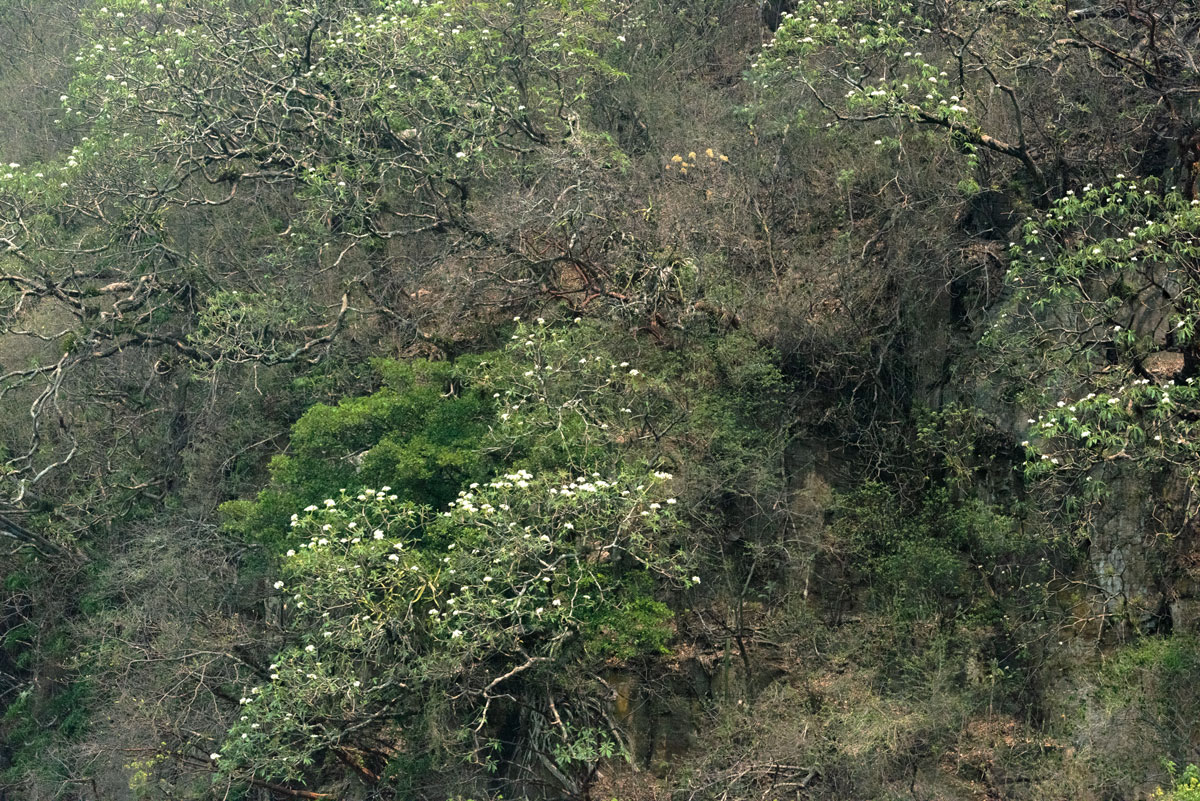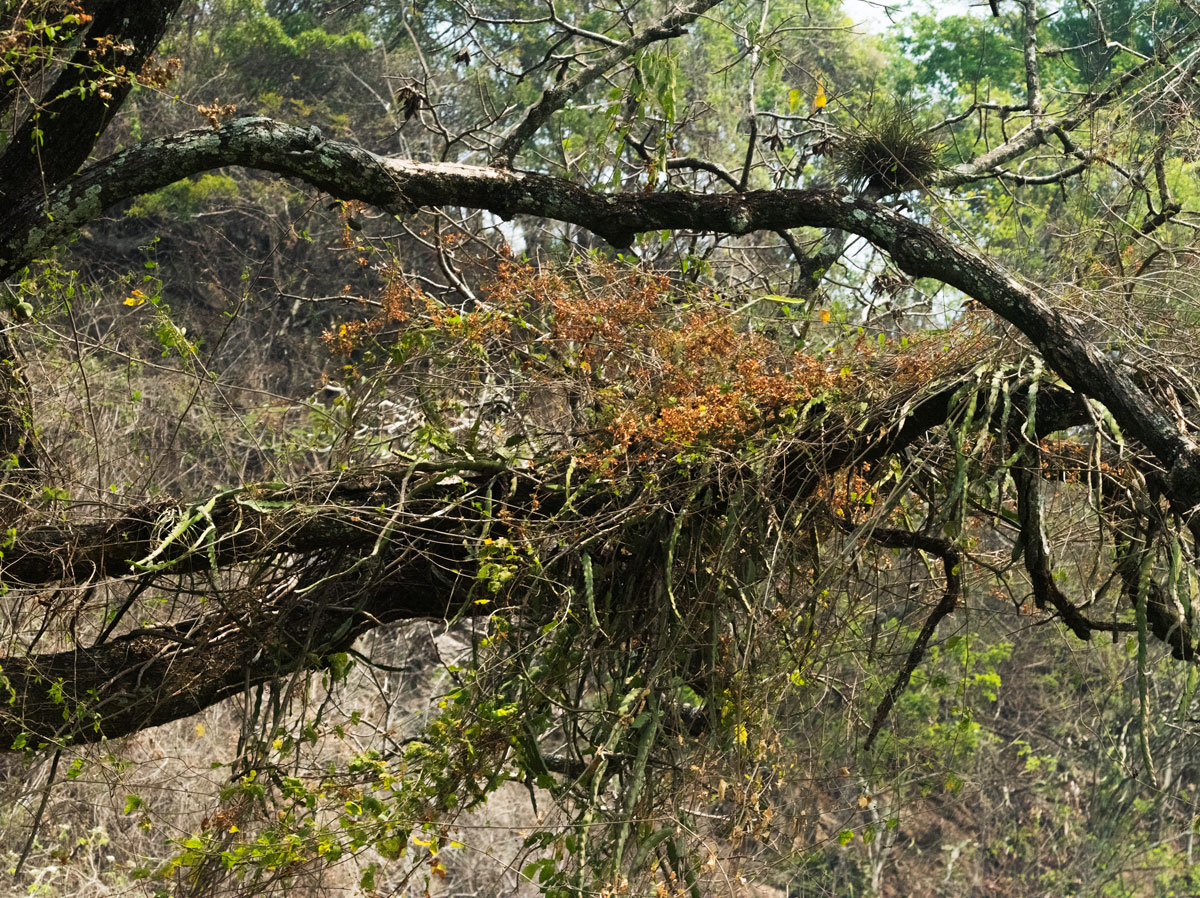Wild Plumeria trees in Guatemala are always with white flowers
All photos in this webpage on Plumeria are by Nicholas Hellmuth with Nikon D810, 200mm Nikkor lens, no tripod because the boat did not have space (but no problem since the flowers are pure white). Northeast side of part of Lake Amatitlan.
We (FLAAR in USA and FLAAR Mesoamerica in Guatemala) have been doing field work to find, photograph, and document where Plumeria trees are flowering in the wild all across Guatemala. After several years of field work (several week-long field trips each year) we noticed that the size, shape, and amount of yellow in the center of the flower varied by region. So I estimate these are regional variants. Best if a botanist makes final decisions.
We also noticed that all WILD native Plumeria were with white flowers, albeit with varying amount of yellow in the center. But pure yellow, pink, dark colored Plumeria were in gardens (or if in the wild, there had been a wooden house there in the previous century and the house had decayed but the pink or maroon colored Plumeria was still growing there).
Bishop Diego de Landa notes lots of different colored Plumeria flowers around Maya houses in Yucatan after the Spanish conquest.
Gates suggests that nicte is the generic name for Plumerias (his page 239). I would prefer a linguistic of the experience level of David Bolles to answer this question since nicte has been discussed by many capable archaeologists and experienced epigraphers. However the mish-mash by some authors has led to copy-and-paste errors for over a century. J. Eric S. Thompson mis-identified 4-petalled flowers perpetually. This is why we today (and for the previous half-century) hike mile after mile, day after day. And we drive thousands of kilometers to reach remote ecosystems. Plus today, we use motorboats to reach biodiverse ecosystems not thoroughly studied by either botanists, ethnobotanists or ecologists (since they intelligently focus on areas easy and comfortable to reach).
So we know these Plumeria flowers of different colors are from pre-Hispanic times. But during my over 5 years of field work to find-and-photograph wild native Plumeria trees throughout Guatemala, I noticed that all the wild ones were white.
This is a typical Plumeria tree, from at least April through June. The local name is Flor de Mayo. We have found a few along Highway CA9 that have flowers for at least four months.
Northeast side of part of Lake Amatitlan. We did not see any Plumeria trees on other sides of Lake Amatitlan but did not go to the far northern end that day.
Plumeria trees like to grow on steep hills
In past years we have found lots of Plumeria trees literally growing out of cliffs, along the edge of barrancas in many areas of Guatemala.
Most of the hills around Lake Amatitlan, if not steep, are partially agricultural or otherwise cut down. The hill where we noticed the most wild native Plumeria trees (northeast side of the lake) was cliffs down by the lake, and steep elsewhere). Perhaps it has not been cut down either because it is too steep or perhaps it is a protected area.
Plumeria trees can also grow on flat areas, but you see them on cliffs and steep hills since these areas are not bulldozed; not chopped down for modern commercial use.
Plumeria like to be on hillsides. But when planted around a home are capable of growing in many other areas. These are wild and native in this northeast side of part of Lake Amatitlan.
Hard to see but lower middle is solid stone cliff; rest is steep hillside. North east side of part of Lake Amatitlan. We will add our GPS map location when our data processing person is back in the office.
Plumeria trees in Guatemala like to grow in same area as cactus plants
We find thousands of Plumeria trees in the Bosque Seco parallel to highway CA9, parallel to Rio Motagua, Km. 90 to past km. 120. Then by km. 150 the hills are more moist as you approach Izabal, and no more wild Plumeria trees (and no more cacti).
So Plumeria trees like bosque seco areas all across Guatemala. So often the Plumeria trees are surrounded by candelabra cactus and giant Opuntia cacti (and their close relatives).
This one hill overlooking an east part of the north area of Lake Amatitlan was both very steep and filled with cacti. There were also arboreal cactus vines in many of the trees.
Would be a great place for students to undertake thesis or PhD dissertation field work and for ecologists to document this area (as most of the other hills are already deforested for commercial crops or houses).
Arboreal cactus on tree limbs. These are in same bosque seco as the Plumeria. Northeast side of part of Lake Amatitlan.
We thank Manolo Ralda for him taking us in a boat around Lake Amatitlan
Our field trip to Lake Amatitlan was organized by Isabel Paiz (FLAAR Mesoamerica). She knows Manolo Ralda who is founder and key person of the NGO, Locos por Amati. You can visit their website to learn more about Lake Amatitlan.
https://www.instagram.com/locosxamati/?igshid=YmMyMTA2M2Y%3D
Manolo Ralda kindly provided a motor boat, life preservers, and fuel to cruise around the shore of parts of Lake Amatitlan. Our goal was to see what waterbirds could be studied at this time of year, and learn when, where, and what species of migratory birds come here so in the future we could return and photograph even more species. But to start with we found lots of Great Blue Heron (Garza gris) and Lead Photographer Edwin Solares also photographed wild ducks and another few waterbird species that we will show later.
But I was pleasantly surprised that I noticed one large hill along the northeast side of Lake Amatitlan was a total bosque seco cactus-filled area that had LOTS of Flor de Mayo Trees (Plumeria species).
The present webpage is to encourage students of ecology and/or botany to tackle this bosque seco niche for a thesis or PhD dissertation.
First posted April 20, 2023.
Written by Nicholas Hellmuth, FLAAR MESOAMERICA


